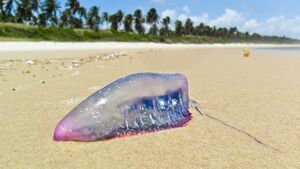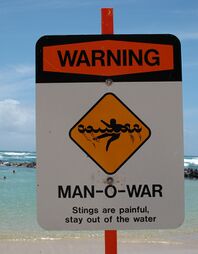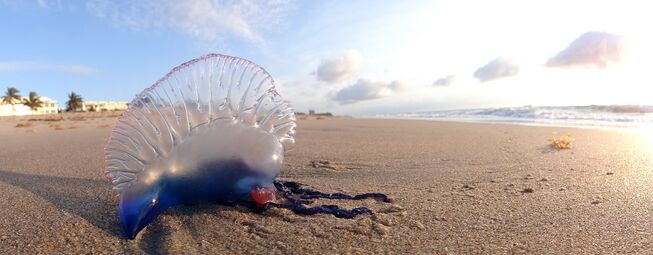البارجة البرتغالية
| البارجة البرتغالية | |
|---|---|

| |
| التصنيف العلمي | |
| أصنوفة غير معروفة (أصلحها): | الحياة |
| مملكة: | الحيوانية |
| Phylum: | لاسعات |
| Class: | هدريات |
| تحت رتبة: | Cystonectae |
| الفصيلة: | الحوصلاء Brandt, 1835[2] |
| الجنس: | الحوصلاء لامارك، 1801[1] |
| Species: | P. physalis
|
| Binomial name | |
| Physalia physalis | |
| Synonyms | |
| |

البارجة البرتغالية أو رجل الحرب البرتغالي (Physalia physalis)، وتُعرف أيضاً باسم رجل الحرب،[6] هو نوع من هدريات البحرية يعيش في المحيطين الأطلسي والهندي. ويُعتبر من نفس نوع رجل حرب المحيط الهادي أو الزجاجة الزرقاء، والذي يتوجد بشكل رئيسي في المحيط الهادي.[7] البارجة البرتغالية هي النوع الوحيد ضمن جنس Physalia، والذي بدوره هو الجنس الوحيد في فصيلة Physaliidae.[8]
تعد البارجة البرتغالية عضواً بارزاً ضمن مجموعة neuston، وهي مجموعة العضيات التي تعيش على سطح المحيط. تحتوي البارجة البرتغالية حتوي على العديد من الخلايا اللاسعة المجهرية السامة التي تُسبب لسعات مؤلمة، الكافية لقتل الأسماك، والتي تتسبب أحياناً في قتل البشر. على الرغم من أنها تشبه قنديل البحر ظاهرياً، إلا أن البارجة البرتغالية في الواقع من حاملات الأنابيب. ومثل جميع حاملات الأنابيب، فهي عضية مستعمرة، تتكون من وحدات أصغر تُسمى zooids.[9] جميع zooid في المستعمرة متطابقة وراثياً، لكنها تؤدي وظائف متخصصة مثل التغذية والتكاثر، وتسمح للمستعمرة بالعمل كفرد واحد.
التصنيف
The blue bottle, Pacific man o' war or Indo-Pacific Portuguese man o' war, distinguished by a smaller float and a single long fishing tentacle, was originally considered a separate species in the same genus (P. utriculus). The name was synonymized with P. physalis in 2007, and it is now considered a regional form of the same species.[10][11]
أصل الاسم
The name man o' war comes from the man-of-war, a sailing warship,[12] and the animal's resemblance to the Portuguese version (the caravel) at full sail.[13][5][6]
استعراض عام
The siphonophore Physalia physalis, commonly known as the Portuguese man o' war, is one of the most conspicuous, but poorly understood, members of the neuston.[9] The neuston is the floating community of ocean organisms that live at the interface between water and air. This community is exposed to a unique set of environmental conditions including prolonged exposure to intense ultraviolet light, desiccation risk, and rough sea and wave conditions.[14] Despite their tolerance for extreme environmental conditions and the very large size of this habitat, which makes up 71% of the Earth’s surface and is nearly three times the area of all terrestrial habitats, very little is known about the organisms that make up this highly specialized polyphyletic community.[15][9]
The Portuguese man o' war is aptly named after a warship: it uses part of an enlarged float filled with carbon monoxide and air as a sail to travel by wind for thousands of miles, dragging behind long tentacles that deliver a deadly venomous sting to fish.[16][17] This sailing ability, combined with a painful sting and a life cycle with seasonal blooms, results in periodic mass beach strandings and occasional human envenomations, making P. physalis the most infamous siphonophore.[15][9]
The development, morphology, and colony organization of P. physalis is very different from all other siphonophores.[9] Siphonophores are a relatively understudied group of colonial hydrozoans. Colonies are composed of functionally specialized bodies (termed zooids) that are homologous to free living individuals. Most species are planktonic and are found at most depths from the deep sea to the surface of the ocean.[18][19][20] They are fragile and difficult to collect intact, and must be collected by submersible, remotely operated vehicle, by hand while blue-water diving, or in regions with localized upwellings.[21][22] However, Physalia physalis is the most accessible, conspicuous, and robust siphonophore, and as such, much has been written about this species, including the chemical composition of its float, venom (especially envenomations), occurrence, and distribution.[15][23][24] Fewer studies, however, have taken a detailed look at P. physalis structure, including development, histology of major zooids, and broader descriptions of colony arrangement.[25][26][27][28] These studies provide an important foundation for understanding the morphology, cellular anatomy, and development of this neustonis species. It can be difficult to understand the morphology, growth, and development of P. physalis within the context of siphonophore diversity, as the colony consists of highly 3-dimensional branching structures and develops very different from all other siphonophores.[9]
The bluebottle resembles a jellyfish but is actually a siphonophore, a colonial organism composed of small individual animals called zooids.[29] There are four zooids depending on each other for survival and performing different functions, such as digestion (gastrozooids), reproduction (gonozooids) and hunting (dactylozooids). The last zooid, the pneumatophore, is a gas-filled float or sac that supports the other zooids and acts like a sail so the bluebottle is constrained to the ocean surface, moving at the mercy of the wind, waves and marine currents. The bluebottle's long tentacles hang below the float as they drift, fishing for prey to sting and drag up to their digestive zooids.[29][30]
The species is found throughout the world's oceans, in tropical, subtropical and (occasionally) temperate regions.[9][30]
التشريح والفسيولوجيا
Anatomy of a Physalia physalis colony [9]
with descriptions of the function of each zooid
Like all siphonophores, the Portuguese man o' war is colonial: each man o' war is composed of many smaller units (zooids) that hang in clusters from under a large, gas-filled structure called the pneumatophore.[31] New zooids are added by budding as the colony grows. As many as seven different kinds of zooids have been described in the man o' war: three of the medusoid type (gonophores, nectophores, and vestigial nectophores) and four of the polypoid type (free gastrozooids, tentacle-bearing zooids, gonozooids and gonopalpons).[32] However, naming and categorization of zooids varies between authors, and much of the embryonic and evolutionary relationships of zooids remains unclear.[9]
The pneumatophore, or bladder, is the most conspicuous part of the man o' war. It is translucent and tinged blue, purple, pink, or mauve, and may be 9 إلى 30 cm (3.5 إلى 11.8 in) long and rise as high as 15 cm (6 in) above the water. The pneumatophore functions as both a flotation device and a sail for the colony, allowing the colony to move with the prevailing wind.[9][31] The gas in the pneumatophore is part carbon monoxide (0.5–13%), which is actively produced by the animal, and part atmospheric gases (nitrogen, oxygen and noble gases) that diffuse in from the surrounding air.[33] In the event of a surface attack, the pneumatophore can be deflated, allowing the colony to temporarily submerge.[34]
The colony hunts and feeds through the cooperation of two types of zooid: gastrozooids and tentacle-bearing zooids known as dactylozooids[9] or tentacular palpons. The dactylozooids are equipped with tentacles, which are typically about 10 m (30 ft) in length but can reach over 30 m (100 ft).[35][36] Each tentacle bears tiny, coiled, thread-like structures called nematocysts. Nematocysts trigger and inject venom on contact, stinging, paralyzing, and killing adult or larval squids and fishes. Large groups of Portuguese man o' war, sometimes over 1,000 individuals, may deplete fisheries.[32][34] Contraction of tentacles drags the prey upward, into range of the gastrozooids, the digestive zooids. The gastrozooids surround and digest the food by secreting enzymes. P. physalis typically has multiple stinging tentacles, but a regional form (previously known as a separate species, P. utriculus) has only a single stinging tentacle.
The main reproductive zooids, the gonophores, are situated on branching structures called gonodendra. Gonophores produce sperm or eggs (see life cycle). Besides gonophores, each gonodendron also contains several other types of specialized zooids: gonozooids (which are accessory gastrozooids), nectophores (which have been speculated to allow detached gonodendra to swim), and vestigial nectophores (also called jelly polyps; the function of these is unclear).[9]
المستعمرات
The man o' war is described as a colonial organism because the individual zooids in a colony are evolutionarily derived from either polyps or medusae,[37] i.e. the two basic body plans of cnidarians.[38] Both of these body plans comprise entire individuals in non-colonial cnidarians (for example, a jellyfish is a medusa; a sea anemone is a polyp). All zooids in a man o' war develop from the same single fertilized egg and are therefore genetically identical; they remain physiologically connected throughout life, and essentially function as organs in a shared body. Hence, a Portuguese man o' war constitutes a single individual from an ecological perspective, but is made up of many individuals from an embryological perspective.[37]
الانتشار
Found mostly in tropical and subtropical waters,[39][40] the Portuguese man-o-war lives at the surface of the ocean. The gas-filled bladder, or pneumatophore, remains at the surface, while the remainder is submerged.[41] Portuguese man-o-war have no means of propulsion, and move passively, driven by the winds, currents, and tides.
Winds can drive them into bays or onto beaches. Often, finding a single Portuguese man o' war is followed by finding many others in the vicinity.[35] The Portuguese man o' war is well known to beachgoers for the painful stings delivered by its tentacles.[30] Because they can sting while beached, the discovery of a man o' war washed up on a beach may lead to the closure of the beach.[42][43]
ديناميكا الانجراف
The bluebottle course at zero angle of attack is dependent on the sail camber [30]
Despite being a common occurrence, the origin of the man 'o war or bluebottle before reaching the coastline is not well understood, and neither is the way it drifts at the surface of the ocean.[30]
الأيمن والأعسر
For each man 'o war or bluebottle, the float can be oriented towards the left or the right (dimorphism), believed to be an adaptation that prevents the entire population from being washed on shore to die.[44][45] The "left-handed" bluebottles sail to the right of the wind, while the "right-handed" bluebottles sail to the left. The wind will always push the two types of bluebottles in different directions, so at most half the population will be pushed towards the coast.[44][45] Regional populations of Portuguese man o' war can have substantial differences in float size and the number of long tentacles used for hunting. The regional form previously known as P. utriculus, the bluebottle, has a float rarely exceeding 10 cm in length and has one long hunting tentacle that is less than 3 m long. In comparison, the typical man o' war has a float of around 15 cm, reported up to 30 cm, and several hunting tentacles that can reach 30 m in mature colonies when fully extended.[9][30]
A Portuguese man o' war is somewhat asymmetrically shaped: the zooids of the colony hang down not quite from the midline of the pneumatophore, but offset to either the right or left side of the midline. When combined with the trailing action of the tentacles (which function as a sea anchor), this left- or right-handedness makes the colony sail sideways relative to the wind, by about 45° in either direction.[46][47] Colony handedness has therefore been theorized to affect man o' war migration, with left-handed or right-handed colonies potentially being more likely to drift down particular respective sea routes.[46] While previously believed to develop as a result of what winds a colony experienced, handedness in fact emerges early in the colony's life, while it is still living below the surface of the sea.[9]
النمذجة الرياضية
Since they cannot swim, the movement of the man 'o war or bluebottle can be modelled mathematically by calculating the forces acting on it, or by advecting virtual particles in ocean and atmospheric circulation models. Earlier studies modelled the movement of the man 'o war with Lagrangian particle tracking to explain major beaching events. In 2017, Ferrer and Pastor were able to estimate the region of origin of a significant beaching event on the Basque coast.[48] They ran a Lagrangian model backwards in time, using wind velocity and a wind drag coefficient as drivers of the man 'o war motion. They found that the region of origin was the North Atlantic subtropical gyre.[48] In 2015 Prieto et al. included both the effect of the surface currents and wind to predict the initial colony position prior to major beaching events in the Mediterranean.[49] This model assumed the man 'o war was advected by the surface currents, with the effect of the wind being added with a much higher wind drag coefficient of 10 percent. Similarly, in 2020 Headlam et al. used beaching and offshore observations to identify a region of origin, using the joint effects of surface currents and wind drag, for the largest mass man 'o war beaching on the Irish coastline in over 150 years.[50][30] These earlier studies used numerical models in combination with simple assumptions to calculate the drift of this species, excluding complex drifting dynamics. In 2021, Lee et al. provide a parameterisation for Lagrangian modelling of the bluebottle by considering the similarities between the bluebottle and a sailboat. This allowed them to compute the hydrodynamic and aerodynamic forces acting on the bluebottle and use an equilibrium condition to create a generalised model for calculating the drifting speed and course of the bluebottle under any wind and ocean current conditions.[30]
البيئة
المفترسون والفرائس
Blue dragon, Glaucus atlanticus
Violet snail, Janthina janthina
The Portuguese man o' war is a carnivore.[35] Using its venomous tentacles, a man o' war traps and paralyzes its prey while "reeling" it inwards to the digestive polyps. It typically feeds on small adult fish and fish fry (young fish), and sometimes zooplankton, shrimp and other small crustaceans.[51]
The organism has few predators of its own; one example is the loggerhead turtle, which feeds on the Portuguese man o' war as a common part of its diet.[52] The turtle's skin, including that of its tongue and throat, is too thick for the stings to penetrate. Also, the blue sea slug Glaucus atlanticus specializes in feeding on the Portuguese man o' war,[53] as does the violet snail Janthina janthina.[54] The ocean sunfish's diet, once thought to consist mainly of jellyfish, has been found to include many species, the Portuguese man o' war being one such example.[55][56]
The blanket octopus is immune to the venom of the Portuguese man o' war; young individuals have been observed to carry broken man o' war tentacles,[57] which males and immature females rip off and use for offensive and defensive purposes.[58]
The man-of-war fish, Nomeus gronovii, is a driftfish native to the Atlantic, Pacific and Indian Oceans. It is notable for its ability to live within the deadly tentacles of the Portuguese man o' war, upon whose tentacles and gonads it feeds. Rather than using mucus to prevent nematocysts from firing, as is seen in some of the clownfish sheltering among sea anemones, the fish appears to use highly agile swimming to physically avoid tentacles.[59][60] The fish has a very high number of vertebrae (41), which may add to its agility[60] and primarily uses its pectoral fins for swimming—a feature of fish that specialize in maneuvering tight spaces. It also has a complex skin design and at least one antigen to the man o' war's toxin.[60] Although the fish seems to be 10 times more resistant to the toxin than other fish, it can be stung by the dactylozooides (large tentacles), which it actively avoids.[59] The smaller gonozooids do not seem to sting the fish and the fish is reported to frequently "nibble" on these tentacles.[59]
المعايشة والتكافل
The Portuguese man o' war is often found with a variety of other marine fish, including yellow jack. These fish benefit from the shelter from predators provided by the stinging tentacles, and for the Portuguese man o' war, the presence of these species may attract other fish to eat.[61]
دورة الحياة
أفراد البارجة البرتغالية هم ثنائيو المسكن، أي أن كل مستعمرة إما أن تكون ذكراً أو أنثى.[31][9] تجلس الگونودفورات التي تنتج الحيوانات المنوية أو البويضات (اعتماداً على جنس المستعمرة) على بنية تشبه الشجرة تسمى الگونودندرون، والتي يُعتقد أنها تسقط من المستعمرة أثناء التكاثر.[9] تتم عملية التزاوج بشكل أساسي في فصل الخريف، عندما يتم إسقاط البيض والحيوانات المنوية من الگونودفورات إلى الماء.[31] نظرًا لأنه لم تُرصد عملية الإخصاب أو التطور المبكر بشكل مباشر في البرية، فمن غير المعروف حتى الآن على أي عمق يحدث ذلك.[9]
تتطور بيضة البارجة البرتغالية المخصبة إلى يرقة تُطلق زويد جديدة أثناء نموها، مُشكلةً تدريجياً مستعمرة جديدة. يحدث هذا التطور في البداية تحت الماء، وقد أُعيد بناؤه بمقارنة مراحل مختلفة من اليرقات التي جُمعت من البحر.[9] أول بنيتين تظهران هما نيوماتوفور (الشراع) ونيوموديد واحد يتغذى مبكراً يُسمى الپروتوزويد؛ لاحقًا، تُضاف الگاستروزويدات والنيوموديدات الحاملة للمجسات. في النهاية، يصبح النيوموتوفور النامي طافياً بما يكفي لحمل المستعمرة غير البالغة على سطح الماء.[9]
السم
The stinging, venom-filled nematocysts in the tentacles of the Portuguese man o' war can paralyze small fish and other prey.[24] Detached tentacles and dead specimens (including those that wash up on shore) can sting just as painfully as those of the live organism in the water and may remain potent for hours or even days after the death of the organism or the detachment of the tentacle.[62]
Stings usually cause severe pain to humans, leaving whip-like red welts on the skin that normally last two or three days after the initial sting. The pain normally subsides after about one to three hours (depending on the victim's biology). However, the venom can travel to the lymph nodes and may cause symptoms that mimic an allergic reaction, including swelling of the larynx, airway blockage, cardiac distress and an inability to breathe. Other symptoms may include fever and shock and, in some extreme cases, even death,[63] although this is extremely rare. Medical attention for those exposed to large numbers of tentacles may become necessary to relieve pain or open airways if the pain becomes excruciating or lasts for more than three hours, or if breathing becomes difficult. Instances in which the stings completely surround the trunk of a young child are among those that may be fatal.[64]
The species is responsible for up to 10,000 human stings in Australia each summer, particularly on the east coast, with some others occurring off the coast of South Australia and Western Australia.[65]
معالجة اللدغات
Stings from a Portuguese man o' war can result in severe dermatitis characterized by long, thin, open wounds that resemble those caused by a whip.[66] These are not caused by any impact or cutting action, but by irritating urticariogenic substances in the tentacles.[67][68]
In 2017, vinegar (acetic acid, 5% acidity) rinsing (irreversibly inhibiting cnidae discharge), then applying heat, water or hot pack, at 45 °C (113 °F), for 45 minutes, was found to be the most effective treatment, while rinsing with seawater, cold packs, urine, baking soda, shaving cream, soap, lemon juice, alcohol, rubbing alcohol, and cola will trigger the release of more venom.[69]
In 2009, isolated studies had suggested that in some individuals vinegar dousing may increase toxin delivery and worsen symptoms.[70][71] In 1988, vinegar was claimed to provoke hemorrhaging when used on the less severe stings of cnidocytes of smaller species.[72]
معرض صور
انظر أيضاً
- Chondrophores (porpitids)، هدريات استعمارية مختلفة.
- Velella, a smaller hydrozoa which has a similar shape and colouration.[73]
- Porpita porpita
- حاملات الأنابيب
المراجع
- ^ Lamarck, J. B. (1801). Système des animaux sans vertèbres, ou tableau général des classes, des ordres et des genres de ces animaux; Présentant leurs caractères essentiels et leur distribution, d'apres la considération de leurs rapports naturels et de leur organisation, et suivant l'arrangement établi dans les galeries du Muséum d'Histoire Naturelle, parmi leurs dépouilles conservées; Précédé du discours d'ouverture du Cours de Zoologie, donné dans le Muséum National d'Histoire Naturelle l'an 8 de la République (Thesis). Published by the author and Deterville, Paris: pp. viii + 432. p. 355. Archived from the original on 2017-05-27.
- ^ Brandt, Johann Friedrich (1834–1835). "Prodromus descriptionis animalium ab H. Mertensio in orbis terrarum circumnavigatione observatorum. Fascic. I., Polypos, Acalephas Discophoras et Siphonophoras, nec non Echinodermata continens". Recueil Actes des séances publiques de l'Acadadémie impériale des Science de St. Pétersbourg 1834: 201–275. page(s): 236
- ^ Schuchert, P. (2019). "World Hydrozoa Database. Physaliidae Brandt, 1835". World Register of Marine Species. Archived from the original on 2018-10-27. Retrieved 2019-03-11.
- ^ Schuchert, P. (2019). World Hydrozoa Database. Physalia Lamarck, 1801. Accessed through: World Register of Marine Species at: http://www.marinespecies.org/aphia.php?p=taxdetails&id=135382 Archived 2016-03-14 at the Wayback Machine on 2019-03-11
- ^ أ ب Schuchert, P. (2019). World Hydrozoa Database. Physalia physalis (Linnaeus, 1758). Accessed through: World Register of Marine Species at: http://www.marinespecies.org/aphia.php?p=taxdetails&id=135479 Archived 2018-07-27 at the Wayback Machine on 2019-03-11
- ^ أ ب قالب:OED
- ^ "Bluebottle factsheet". Western Australian Museum. Archived from the original on 21 March 2015. Retrieved 12 August 2015.
- ^ "WoRMS - World Register of Marine Species - Physalia Lamarck, 1801". www.marinespecies.org. Retrieved 2021-10-24.
- ^ أ ب ت ث ج ح خ د ذ ر ز س ش ص ض ط ظ ع غ ف Munro, Catriona; Vue, Zer; Behringer, Richard R.; Dunn, Casey W. (2019-10-29). "Morphology and development of the Portuguese man of war, Physalia physalis". Scientific Reports. Springer Science and Business Media LLC. 9 (1): 15522. Bibcode:2019NatSR...915522M. doi:10.1038/s41598-019-51842-1. ISSN 2045-2322. PMC 6820529. PMID 31664071.
 Material was copied from this source, which is available under a Creative Commons Attribution 4.0 International License.
Material was copied from this source, which is available under a Creative Commons Attribution 4.0 International License.
- ^ Bardi, J.; Marques, A. C. (2007). "Taxonomic redescription of the Portuguese man-of-war, Physalia physalis (Cnidaria, Hydrozoa, Siphonophorae, Cystonectae) from Brazil". Iheringia. Série Zoologia. 97 (4): 425–433. doi:10.1590/S0073-47212007000400011.
- ^ Schuchert, P. (2022). "World Hydrozoa Database. Physalia utriculus (Gmelin, 1788)". WoRMS. World Register of Marine Species. Retrieved 1 March 2022.
- ^ Greene, Thomas F. (1998). Marine Science: Marine Biology and Oceanography (in الإنجليزية). Amsco School Publications. ISBN 978-0-87720-071-0.
high school textbook
- ^ Millward, David (8 September 2012). "Surge in number of men o'war being washed up on beaches". The Daily Telegraph. Archived from the original on 2012-10-31. Retrieved 2012-09-07.
- ^ Zaitsev Y, Liss P (1997). "Neuston of seas and oceans". In Duce R (ed.). The sea surface and global change. Cambridge New York: Cambridge University Press. ISBN 978-0-521-01745-9. OCLC 847978750.
- ^ أ ب ت Prieto, L.; MacÍas, D.; Peliz, A.; Ruiz, J. (2015). "Portuguese Man-of-War (Physalia physalis) in the Mediterranean: A permanent invasion or a casual appearance?". Scientific Reports. 5: 11545. Bibcode:2015NatSR...511545P. doi:10.1038/srep11545. PMC 4480229. PMID 26108978.
- ^ Clark, F. E.; Lane, C. E. (1961). "Composition of Float Gases of Physalia physalis". Experimental Biology and Medicine. 107 (3): 673–674. doi:10.3181/00379727-107-26724. PMID 13693830. S2CID 2687386.
- ^ Iosilevskii, G.; Weihs, D. (2009). "Hydrodynamics of sailing of the Portuguese man-of-war Physalia physalis". Journal of the Royal Society Interface. 6 (36): 613–626. doi:10.1098/rsif.2008.0457. PMC 2696138. PMID 19091687.
- ^ Mapstone, Gillian M. (2014). "Global Diversity and Review of Siphonophorae (Cnidaria: Hydrozoa)". PLOS ONE. 9 (2): e87737. Bibcode:2014PLoSO...987737M. doi:10.1371/journal.pone.0087737. PMC 3916360. PMID 24516560.
- ^ Munro, Catriona; Siebert, Stefan; Zapata, Felipe; Howison, Mark; Damian-Serrano, Alejandro; Church, Samuel H.; Goetz, Freya E.; Pugh, Philip R.; Haddock, Steven H.D.; Dunn, Casey W. (2018). "Improved phylogenetic resolution within Siphonophora (Cnidaria) with implications for trait evolution". Molecular Phylogenetics and Evolution. 127: 823–833. doi:10.1016/j.ympev.2018.06.030. PMC 6064665. PMID 29940256.
- ^ Pugh, P.R. (1984). "The diel migrations and distributions within a mesopelagic community in the North East Atlantic. 7. Siphonophores". Progress in Oceanography. 13 (3–4): 461–489. Bibcode:1984PrOce..13..461P. doi:10.1016/0079-6611(84)90016-8.
- ^ Dunn, Casey W.; Pugh, Philip R.; Haddock, Steven H. D. (2005). "Molecular Phylogenetics of the Siphonophora (Cnidaria), with Implications for the Evolution of Functional Specialization". Systematic Biology. 54 (6): 916–935. doi:10.1080/10635150500354837. PMID 16338764.
- ^ MacKie, G.O.; Pugh, P.R.; Purcell, J.E. (1988). Siphonophore Biology. Advances in Marine Biology. Vol. 24. pp. 97–262. doi:10.1016/S0065-2881(08)60074-7. ISBN 9780120261246.
- ^
- Araya, Juan Francisco; Aliaga, Juan Antonio; Araya, Marta Esther (2016). "On the distribution of Physalia physalis (Hydrozoa: Physaliidae) in Chile". Marine Biodiversity. 46 (3): 731–735. doi:10.1007/s12526-015-0417-6. S2CID 2646975.
- Copeland, D. Eugene (1968). "Fine Structures of the Carbon Monoxide Secreting Tissue in the Float of Portuguese Man-of-War (Physalia physalis L.)". Biological Bulletin. 135 (3): 486–500. doi:10.2307/1539711. JSTOR 1539711.
- Herring, Peter J. (1971). "Biliprotein coloration of Physalia physalis". Comparative Biochemistry and Physiology Part B: Comparative Biochemistry. 39 (4): 739–746. doi:10.1016/0305-0491(71)90099-X.
- Lane, Charles E. (2006). "The Toxin of Physalia Nematocysts". Annals of the New York Academy of Sciences. 90 (3): 742–750. doi:10.1111/j.1749-6632.1960.tb26418.x. PMID 13758711. S2CID 44654850.
- Larimer, James L.; Ashby, Ebert A. (1962). "Float gases, gas secretion and tissue respiration in the Portuguese man-of-war,Physalia". Journal of Cellular and Comparative Physiology. 60: 41–47. doi:10.1002/jcp.1030600106.
- Totton, A. K.; MacKie, G. O. (1956). "Dimorphism in the Portuguese Man-of-War". Nature. 177 (4502): 290. Bibcode:1956Natur.177..290T. doi:10.1038/177290b0. S2CID 4296257.
- Wilson, Douglas P. (1947). "The Portuguese Man-of-War, Physalia Physalis L., in British and Adjacent Seas" (PDF). Journal of the Marine Biological Association of the United Kingdom. 27 (1): 139–172. doi:10.1017/s0025315400014156. PMID 18919646. S2CID 28767812.
- Wittenberg, Jonathan B. (1960). "The Source of Carbon Monoxide in the Float of the Portuguese Man-of-War, Physalia Physalis L". Journal of Experimental Biology. 37 (4): 698–705. doi:10.1242/jeb.37.4.698.
- Wittenberg, JB; Noronha, JM; Silverman, M. (1962). "Folic acid derivatives in the gas gland of Physalia physalis L". Biochemical Journal. 85: 9–15. doi:10.1042/bj0850009. PMC 1243904. PMID 14001411.
- Woodcock, A. H. (1956). "Dimorphism in the Portuguese Man-of-War". Nature. 178 (4527): 253–255. Bibcode:1956Natur.178..253W. doi:10.1038/178253a0. S2CID 4297968.
- ^ أ ب Yanagihara, Angel A.; Kuroiwa, Janelle M.Y.; Oliver, Louise M.; Kunkel, Dennis D. (December 2002). "The ultrastructure of nematocysts from the fishing tentacle of the Hawaiian bluebottle, Physalia utriculus (Cnidaria, Hydrozoa, Siphonophora)" (PDF). Hydrobiologia. 489 (1–3): 139–150. doi:10.1023/A:1023272519668. S2CID 603421. Archived from the original (PDF) on 2016-03-04.
- ^ Bardi, J. & Marques, A. C. (2007)" Taxonomic redescription of the Portuguese man-of-war, Physalia physalis (Cnidaria, Hydrozoa, Siphonophorae, Cystonectae) from Brazil". Iheringia Ser. Zool. 97: 425–433
- ^ Mackie, G. O. (1960) "Studies on Physalia physalis (L.). Part 2. Behavior and histology". Discovery Reports. 30: 371–407.
- ^ Okada, Y. K. (1932) "Développement post-embryonnaire de la Physalie Pacifique". Mem. Coll. Sci. Kyoto Imp. Univ., Ser. B, Biol, 8: 1–27.
- ^ Totton, A. K. (1960) "Studies on Physalia physalis (L.). Part 1. Natural history and morphology". Discovery Reports, 30: 301–368.
- ^ أ ب Totton, A. and Mackie, G. (1960) "Studies on Physalia physalis", Discovery Reports, 30: 301–407.
- ^ أ ب ت ث ج ح خ د Lee, Daniel; Schaeffer, Amandine; Groeskamp, Sjoerd (1 October 2021). "Drifting dynamics of the bluebottle (Physalia physalis)". Ocean Science. Copernicus GmbH. 17 (5): 1341–1351. Bibcode:2021OcSci..17.1341L. doi:10.5194/os-17-1341-2021. ISSN 1812-0792. S2CID 244189437.
{{cite journal}}: CS1 maint: unflagged free DOI (link) Material was copied from this source, which is available under a Creative Commons Attribution 4.0 International License.
Material was copied from this source, which is available under a Creative Commons Attribution 4.0 International License.
- ^ أ ب ت ث "Physalia physalis, Portuguese man-of-war". Animal Diversity Web. Museum of Zoology, University of Michigan. Retrieved 10 February 2021.
- ^ أ ب Bardi, Juliana; Marques, Antonio C (2007). "Taxonomic redescription of the Portuguese man-of-war, Physalia physalis (Cnidaria, Hydrozoa, Siphonophorae, Cystonectae) from Brazil" (PDF). Iheringia, Sér. Zool. Brazil: Fundação Zoobotânica do Rio Grande do Sul. 97 (4): 425–433. doi:10.1590/S0073-47212007000400011. ISSN 1678-4766. Archived from the original (PDF) on 2017-03-29.
- ^ Wittenberg, Jonathan B. (1960-01-12). "The Source of Carbon Monoxide in the Float of the Portuguese Man-of-War, Physalia physalis L" (PDF). Journal of Experimental Biology. 37 (4): 698–705. doi:10.1242/jeb.37.4.698. ISSN 0022-0949. Archived from the original (PDF) on 2016-08-04. Retrieved 2013-02-12.
- ^ أ ب "Portuguese Man-of-War". National Geographic Animals. National Geographic. 11 November 2010. Retrieved 2021-03-08.
- ^ أ ب ت "Portuguese Man-of-War". National Geographic Society. Archived from the original on 2011-07-23. Retrieved 2008-06-13.
- ^ NOAA (27 يوليو 2015). "What is a Portuguese Man o' War?". National Ocean Service. Archived from the original on 22 فبراير 2016. Retrieved 8 فبراير 2016.
Updated 10 October 2017
- ^ أ ب Dunn, Casey. "Colonial organization". Siphonophores. Retrieved 10 February 2021.
- ^ "Polyp and medusa body shapes". Te Ara, the Encyclopedia of New Zealand. Manatū Taonga/Ministry for Culture and Heritage, Wellington, New Zealand. Retrieved 10 February 2021.
- ^ "What is a Portuguese Man o' War?". NOAA. Retrieved August 17, 2020.
- ^ "Portuguese Man-O'-War". britishseafishing.co.uk. 24 April 2014. Retrieved August 17, 2020.
- ^ Clark, F. E.; C. E. Lane (1961). "Composition of float gases of Physalia physalis". Proceedings of the Society for Experimental Biology and Medicine. 107 (3): 673–674. doi:10.3181/00379727-107-26724. PMID 13693830. S2CID 2687386.
- ^ "Dangerous jellyfish wash up". BBC News. 2008-08-18. Archived from the original on 2011-05-11. Retrieved 2011-09-07./
- ^ "Man-of-war spotted along coast in Cornwall and Wales". BBC. 12 سبتمبر 2017. Archived from the original on 5 مارس 2018. Retrieved 20 يوليو 2018.
- ^ أ ب Totton, A. and Mackie, G. (1960) "Studies on Physalia physalis", Discovery Reports, 30: 301–40.
- ^ أ ب Woodcock, A. H. (1944) "A theory of surface water motion deduced from the wind-induced motion of the Physalia", J. Marine Res., 5: 196–205.
- ^ أ ب Woodcock, A. H. (1956). "Dimorphism in the Portuguese man-of-war". Nature. 178 (4527): 253–255. Bibcode:1956Natur.178..253W. doi:10.1038/178253a0. S2CID 4297968.
- ^ Iosilevskii, G.; Weihs, D. (2009). "Hydrodynamics of sailing of the Portuguese man-of-war Physalia physalis". Journal of the Royal Society Interface. 6 (36): 613–626. doi:10.1098/rsif.2008.0457. PMC 2696138. PMID 19091687.
- ^ أ ب Ferrer, Luis; Pastor, Ane (2017). "The Portuguese man-of-war: Gone with the wind". Regional Studies in Marine Science. 14: 53–62. doi:10.1016/j.rsma.2017.05.004.
- ^ Prieto, L.; Macías, D.; Peliz, A.; Ruiz, J. (25 June 2015). "Portuguese Man-of-War (Physalia physalis) in the Mediterranean: A permanent invasion or a casual appearance?". Scientific Reports. Springer Science and Business Media LLC. 5 (1): 11545. Bibcode:2015NatSR...511545P. doi:10.1038/srep11545. ISSN 2045-2322. PMC 4480229. PMID 26108978. S2CID 8456129.
- ^ Headlam, Jasmine L.; Lyons, Kieran; Kenny, Jon; Lenihan, Eamonn S.; Quigley, Declan T.G.; Helps, William; Dugon, Michel M.; Doyle, Thomas K. (2020). "Insights on the origin and drift trajectories of Portuguese man of war (Physalia physalis) over the Celtic Sea shelf area". Estuarine, Coastal and Shelf Science. 246: 107033. Bibcode:2020ECSS..24607033H. doi:10.1016/j.ecss.2020.107033. S2CID 224908448.
- ^ "Physalia physalis (Portuguese man-of-war)".
- ^ Brodie, Edmund D. Jr. (1989). Venomous Animals: 300 Animals in Full Color (in الإنجليزية). Golden Press. ISBN 978-0-307-24074-3.
- ^ Scocchi, Carla; Wood, James B. "Glaucus atlanticus, Blue Ocean Slug". Thecephalopodpage.org. Archived from the original on 2017-10-05. Retrieved 2009-12-07.
- ^ Morrison, Sue; Storrie, Ann (1999). Wonders of Western Waters: The Marine Life of South-Western Australia. CALM. p. 68. ISBN 978-0-7309-6894-8.
- ^ Sousa, Lara L.; Xavier, Raquel; Costa, Vânia; Humphries, Nicolas E.; Trueman, Clive; Rosa, Rui; Sims, David W.; Queiroz, Nuno (4 July 2016). "DNA barcoding identifies a cosmopolitan diet in the ocean sunfish". Scientific Reports. 6 (1): 28762. Bibcode:2016NatSR...628762S. doi:10.1038/srep28762. PMC 4931451. PMID 27373803.
- ^ Portuguese Man o' War, Oceana, http://oceana.org/marine-life/corals-and-other-invertebrates/portuguese-man-o-war, retrieved on 2017-04-02
- ^ "Tremoctopus". Tolweb.org. Archived from the original on 2009-07-29. Retrieved 2009-12-07.
- ^ Jones, E.C. (1963). "Tremoctopus violaceus uses Physalia tentacles as weapons". Science. 139 (3556): 764–766. Bibcode:1963Sci...139..764J. doi:10.1126/science.139.3556.764. PMID 17829125. S2CID 40186769.
- ^ أ ب ت Jenkins, Robert L. (10 February 1983). "Observations on the Commensal Relationship of Nomeus gronovii with Physalia physalis". Copeia. 1983 (1): 250–252. doi:10.2307/1444723. JSTOR 1444723. Retrieved 22 October 2022.
- ^ أ ب ت Purcell, Jennifer E.; Arai, Mary N. (2001). "Interactions of pelagic cnidarians and ctenophores with fish: A review". Hydrobiologia. 451 (1/3): 27–44. doi:10.1023/A:1011883905394. S2CID 31059411. Retrieved 22 October 2022. PDF
- ^ Piper, Ross (2007). Extraordinary Animals: An Encyclopedia of Curious and Unusual Animals. Greenwood Press.
- ^ Auerbach, Paul S. (December 1997). "Envenomations from jellyfish and related species". J Emerg Nurs. 23 (6): 555–565. doi:10.1016/S0099-1767(97)90269-5. PMID 9460392.
- ^ Stein, Mark R.; Marraccini, John V.; Rothschild, Neal E.; Burnett, Joseph W. (March 1989). "Fatal Portuguese man-o'-war (Physalia physalis) envenomation". Ann Emerg Med. 18 (3): 312–315. doi:10.1016/S0196-0644(89)80421-4. PMID 2564268.
- ^ Richard A. Clinchy (1996). Dive First Responder. Jones & Bartlett Learning. p. 19. ISBN 978-0-8016-7525-6. Archived from the original on 2017-02-17. Retrieved 2016-11-03.
- ^ Fenner, Peter J.; Williamson, John A. (December 1996). "Worldwide deaths and severe envenomation from jellyfish stings". Medical Journal of Australia. 165 (11–12): 658–661. doi:10.5694/j.1326-5377.1996.tb138679.x. ISSN 0025-729X. PMID 8985452. S2CID 45032896.
In Australia, particularly on the east coast, up to 10 000 stings occur each summer from the bluebottle (Physalia spp.) alone, with others also from the "hair jellyfish" (Cyanea) and "blubber" (Catostylus). Common stingers in South Australia and Western Australia, include bluebottle, as well the four-tentacled cubozoa or box jellyfish, the "jimble" (Carybdea rastoni)
- ^ "Image Collection: Bites and Infestations: 26. Picture of Portuguese Man of War Sting". www.medicinenet.com (in الإنجليزية). MedicineNet Inc. Archived from the original on 2018-06-03. Retrieved 2014-06-13.
The sting of the Portuguese man-of-war. One of the most painful effects on skin is the consequence of attack by oceanic hydrozoans known as Portuguese men-of-war, which are amazing for their size, brilliant color, and power to induce whealing. They have a small float that buoys them up and from which hang long tentacles. The wrap of these tentacles results in linear stripes, which look like whiplashes, caused not by the force of their sting but from deposition of proteolytic venom toxins, urticariogenic and irritant substances.
- ^ James, William D.; Berger, Timothy G.; Elston, Dirk M.; Odom, Richard B. (2006). Andrews' Diseases of the Skin: Clinical Dermatology. Saunders Elsevier. p. 429. ISBN 978-0-7216-2921-6.
- ^ Rapini, Ronald P.; Bolognia, Jean L.; Jorizzo, Joseph L. (2007). Dermatology: 2-Volume Set. St. Louis: Mosby. ISBN 978-1-4160-2999-1.
- ^
- Wilcox, Christie; Headlam, Jasmine; Doyle, Thomas; Yanagihara, Angel (26 April 2017). "Assessing the Efficacy of First-Aid Measures in Physalia sp. Envenomation, Using Solution- and Blood Agarose-Based Models". Toxins. 9 (5): 149. doi:10.3390/toxins9050149. PMC 5450697. PMID 28445412.

- Lewis, Amy (9 May 2017). "What is the best antidote for a jellyfish sting? (Clue: it's not urine)". the Guardian (in الإنجليزية). Retrieved 22 October 2022.
- Yoshimoto, C.M.; Yanagihara, A.A. (May–June 2002). "Cnidarian (coelenterate) envenomations in Hawai'i improve following heat application". Transactions of the Royal Society of Tropical Medicine and Hygiene. 96 (3): 300–303. doi:10.1016/s0035-9203(02)90105-7. PMID 12174784. Archived from the original on 2019-04-03. Retrieved 2019-04-03.
- Loten, Conrad; Stokes, Barrie; Worsley, David; Seymour, Jamie E.; Jiang, Simon; Isbister, Geoffrey K. (3 April 2006). "A randomised controlled trial of hot water (45 °C) immersion versus ice packs for pain relief in bluebottle stings" (PDF). Medical Journal of Australia. 184 (7): 329–333. doi:10.5694/j.1326-5377.2006.tb00265.x. PMID 16584366. S2CID 14684627. Archived from the original (PDF) on 2019-04-03.
- Ward, Nicholas T.; Darracq, Michael A.; Tomaszewski, Christian; Clark, Richard F. (October 2012). "Evidence-Based Treatment of Jellyfish Stings in North America and Hawaii" (PDF). Annals of Emergency Medicine. 60 (4): 399–414. doi:10.1016/j.annemergmed.2012.04.010. PMID 22677532. Retrieved 22 October 2022.
- "SOEST scientists scrutinize first aid for man o' war stings". School of Ocean and Earth Science and Technology, University of Hawai‘i at Manoa.
- "Rapid Relief for Jellyfish Stings and Fire Ant Bites". Sting No More. Alatalab Solutions, LLC. Archived from the original on 2016-04-03. Retrieved 22 October 2022.
- Wilcox, Christie; Headlam, Jasmine; Doyle, Thomas; Yanagihara, Angel (26 April 2017). "Assessing the Efficacy of First-Aid Measures in Physalia sp. Envenomation, Using Solution- and Blood Agarose-Based Models". Toxins. 9 (5): 149. doi:10.3390/toxins9050149. PMC 5450697. PMID 28445412.
- ^ "Ambulance Fact Sheet: Bluebottle Stings" (PDF). www.ambulance.nsw.gov.au (in الإنجليزية الأسترالية). Ambulance Service of New South Wales. July 2009. Archived from the original (PDF) on 2015-07-14. Retrieved 2018-06-03.
- ^ Slaughter, R.J.; Beasley, D.M.; Lambie, B.S.; Schep, L.J. (2009). "New Zealand's venomous creatures". New Zealand Medical Journal. 122 (1290): 83–97. PMID 19319171. Archived from the original on 2019-04-04. Retrieved 2019-04-03.
- ^ Exton, D.R. (1988). "Treatment of Physalia physalis envenomation". Medical Journal of Australia. 149 (1): 54. doi:10.5694/j.1326-5377.1988.tb120494.x. PMID 2898725. S2CID 20299200.
- ^ "IPMA - Detalhe noticia". www.ipma.pt (in Portuguese). Retrieved 21 May 2021.
{{cite web}}: CS1 maint: unrecognized language (link)
للاستزادة
- Mapstone, Gillian (February 6, 2014). "Global Diversity and Review of Siphonophorae (Cnidaria: Hydrozoa)". PLOS ONE. 9 (2): e87737. Bibcode:2014PLoSO...987737M. doi:10.1371/journal.pone.0087737. PMC 3916360. PMID 24516560.
وصلات خارجية
 Information related to Physalia physalis from Wikispecies.
Information related to Physalia physalis from Wikispecies.- Siphonophores.org General information
- Portuguese Man-of-War National Geographic
- Blue bottle Life In The Fast Lane
- PortugueseManOfWar.com
- Physalia physalis discussed on RNZ Critter of the Week, 24 December 2021.
- CS1 maint: unflagged free DOI
- CS1 الإنجليزية الأسترالية-language sources (en-au)
- Short description is different from Wikidata
- Automatic taxobox cleanup
- Articles with hatnote templates targeting a nonexistent page
- Physaliidae
- Cystonectae
- لاسعات المحيط الأطلسي
- لاسعات المحيط الهندي
- لاسعات المحيط الهادي
- لاسعات بحر الكاريبي
- حيوانات وُصفت في 1758
- أصنوفات سماها كارل لينايوس
- حيوانات سامة
![Anatomy of a Physalia physalis colony [9] with descriptions of the function of each zooid](/w/images/thumb/b/bd/Anatomy_of_a_Physalia_physalis_colony.png/898px-Anatomy_of_a_Physalia_physalis_colony.png)
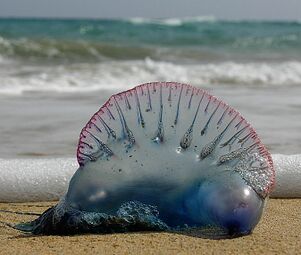
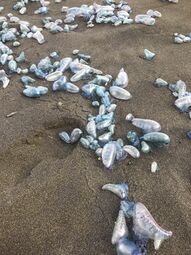

![The bluebottle course at zero angle of attack is dependent on the sail camber [30]](/w/images/thumb/b/b2/Bluebottle_%28Physalia_physalis%29_sail_camber.png/288px-Bluebottle_%28Physalia_physalis%29_sail_camber.png)
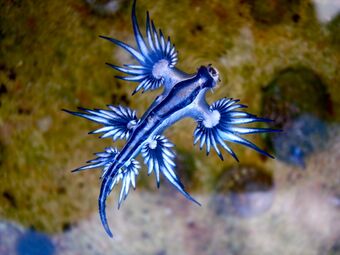
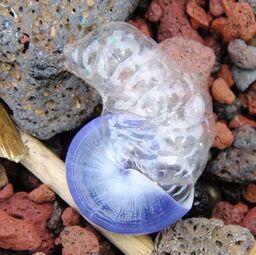
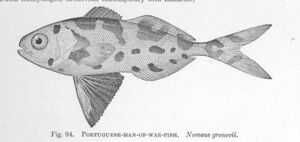
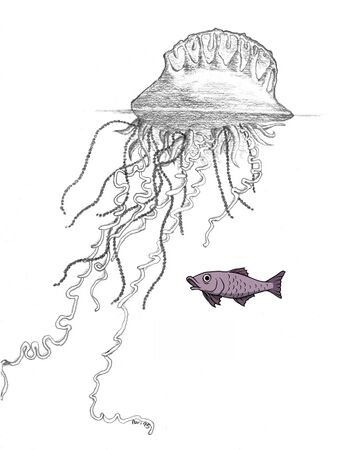
![دورة حياة البارجة البرتغالية [9] تظهر في الصورة بارجة برتغالية بالغة تطفو على سطح المحيط، بينما يُعتقد أن مراحل نموها المبكرة تحدث على عمق غير معروف تحت سطح المحيط. ويُعتقد أن الگونودندرا تنطلق من المستعمرة عند نضجها. ولم تُرصد مرحلة البيضة واليرقات الرحالة.](/w/images/thumb/4/40/Lifecycle_of_the_Portuguese_man_of_war.png/571px-Lifecycle_of_the_Portuguese_man_of_war.png)
